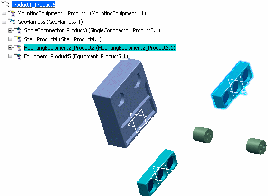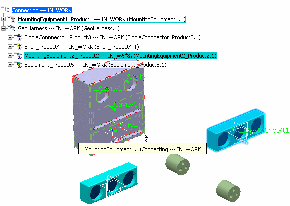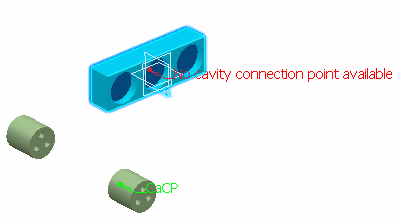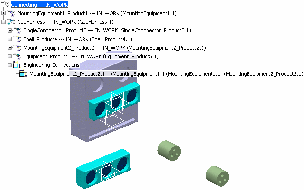Connecting Electrical Devices
This task shows you how to connect electrical devices and select the available Connection Points.
Note:
Place devices directly under an electrical geometry, so that you can
use contextual engineering connections and constraints. For more
information about engineering connections, see Assembly
Design User's Guide.
In the Electrical Assembly Design workbench, click Connect
Devices
 or select Tools > Device Connection > Connect
Devices to connect two devices. or select Tools > Device Connection > Connect
Devices to connect two devices.
Select the first device in the geometry area or in the
specification tree:

Move the cursor over the second device before selecting it, as
shown below:
The cavity connection point of the first device and the cavities of
the second one are displayed in green: this means that it is
possible to connect the first device to any of the four cavities
available on the second one.

If a cavity is already used or if no connection point is defined on the second device, it is displayed in red:

Click to select an available connection point on the device, Cavity3 for example.
Devices are connected and mechanical constraints are added to the
specification tree:

Note:
You can select the second connection point in one of three
ways and get the same result. You can select the:
- Representation of the connection point in the geometry area
- Corresponding label
- Connection Point in the specification tree.

Managing Deactivated Constraints
You can reuse Connection Points in different configurations by deactivating the engineering connection and then reconnect them to another element.
In general, the deactivated connections will always be ignored by Electrical commands.
- The presence of deactivated engineering connection will not prevent from creating a new engineering connection with the Connect Devices
 command. command.
- The deactivated engineering connection will not be removed by Disconnect Devices
 command. command.
- The Link Review command will not display links through deactivated engineering connection.
Launch Connect Devices command.
Select both devices. Launch Link review tool to check the links of both devices.
Launch the Disconnect devices command to disconnect the two devices.
Ensure the two devices have activated and deactivated connection for a given connection point. Run the knowledge rule, AnalyzeElectricalConnectionPoint, for analyzing this
connection point. Please refer to Electrical User Functions.
If two devices are connected, but the engineering connection relations are deactivated. Both the devices can be re-connected through the same connection points. The labels for connection points (which are already connected but engineering connection relations are deactivated) will be displayed in Yellow and selectable while creating new connection. The two devices, already connected through deactivated relations, can be connected:
- to a third device
- or with each other
Note:
Special cases:
- If an engineering connection exists and its relations are active. The connection point labels shown in Red will not be selectable. The user will not be allowed to connect the two devices again, mutually or with any other device. A message will appear, explaining that the selected connector connection point of the electrical device is already used.
- If any of the two devices connected through deactivated relation is connected to third device, a warning will inform you about the existing deactivated relations using one / both selected connection points and ask for confirmation for the creation of the new engineering connection.
- If you try to re-connect two connection points which are simultaneously used in single engineering connection, which is deactivated, then instead of creating new connection, the deactivated relations between parent devices will be activated. A warning will be displayed to the user to get confirmation about the activation of existing engineering connection relations.
|
![]()
 command.
command. command.
command. shows that the device is in
shows that the device is in 


